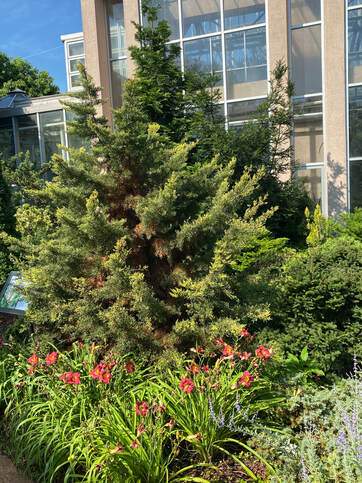Juneperus Chinensis
By: Jalen S
Age: 18
Atlanta, Georgia, USA
By: Jalen S
Age: 18
Atlanta, Georgia, USA
 Photo Credit: Jalen S
Photo Credit: Jalen S
One of the most festive times of the year is Christmas, and a popular American tradition is hanging and decorating Christmas trees that sit in our living rooms. While Juniperus chinensis is not traditionally used as a Christmas tree, they share many similarities with other conifers. Conifer tree characteristic features include needle or scale-like textures, deep forestry green color tones, and having dimensions ranging from 50ft tall to 20ft wide. Besides looking decorative, the Juniperus chinensis is a dioecious evergreen conifer tree, meaning they have a male tree and a female tree. Many Juniperus chinensis can be found in the Western parts of the United States, but the plant originated in China, Japan, and the Himalayas.
Aside from looking like a Christmas tree, the Juniperus chinensis has some ecological and medicinal benefits. Chinensis berries have been known to provide a source of vitamin C and reduce inflammation along with internal gases found within the body. In addition, juniper berries contain chemical compounds that aid in the fight against diseases, bacteria, and viruses. These contain flavonoid antioxidants, volatile oils, and coumarins that have chemical protective properties which contribute to the plants medicinal benefits. Along with the juniper’s medicinal benefits, juniper berries have been known to have a similar taste to gin and a slightly peppery taste.
The first use of Juniper berries was back in 1500 B. C. E from Egyptian’s, used to treat tapeworms. Then it has been recorded that Indigenous people in Southern California used Juniper berries for medicinal benefits too. For many years the juniper oil was inhaled to treat bronchitis and numb pain. The Juniper chinensis is also beneficial ecologically as Junipers increase water resources, prevent soil erosion, as well as provide a source of good quality building material and firewood.
Bibliography:
“Juniper: Health Benefits, Side Effects, Uses, Dose & Precautions.” RxList, RxList, 11 June 2021, www.rxlist.com/juniper/supplements.htm.
Juniperus Chinensis - Plant Finder, www.missouribotanicalgarden.org/PlantFinder/PlantFinderDetails.aspx?taxonid=279597.
“Juniper.” Dictionary.com, Dictionary.com, www.dictionary.com/browse/juniper.
“Native American Juniper Mythology.” Native American Indian Juniper Medicine, Meaning and Symbolism from the Myths of Many Tribes, www.native-languages.org/legends-juniper.htm#:~:text=The%20Interior%20Salish%20and%20Northwest,and%20protect%20themselves%20from%20witchcraft.&text=Juniper%20berries%20were%20also%20eaten,frequently%20used%20as%20medicinal%20herbs.
Aside from looking like a Christmas tree, the Juniperus chinensis has some ecological and medicinal benefits. Chinensis berries have been known to provide a source of vitamin C and reduce inflammation along with internal gases found within the body. In addition, juniper berries contain chemical compounds that aid in the fight against diseases, bacteria, and viruses. These contain flavonoid antioxidants, volatile oils, and coumarins that have chemical protective properties which contribute to the plants medicinal benefits. Along with the juniper’s medicinal benefits, juniper berries have been known to have a similar taste to gin and a slightly peppery taste.
The first use of Juniper berries was back in 1500 B. C. E from Egyptian’s, used to treat tapeworms. Then it has been recorded that Indigenous people in Southern California used Juniper berries for medicinal benefits too. For many years the juniper oil was inhaled to treat bronchitis and numb pain. The Juniper chinensis is also beneficial ecologically as Junipers increase water resources, prevent soil erosion, as well as provide a source of good quality building material and firewood.
Bibliography:
“Juniper: Health Benefits, Side Effects, Uses, Dose & Precautions.” RxList, RxList, 11 June 2021, www.rxlist.com/juniper/supplements.htm.
Juniperus Chinensis - Plant Finder, www.missouribotanicalgarden.org/PlantFinder/PlantFinderDetails.aspx?taxonid=279597.
“Juniper.” Dictionary.com, Dictionary.com, www.dictionary.com/browse/juniper.
“Native American Juniper Mythology.” Native American Indian Juniper Medicine, Meaning and Symbolism from the Myths of Many Tribes, www.native-languages.org/legends-juniper.htm#:~:text=The%20Interior%20Salish%20and%20Northwest,and%20protect%20themselves%20from%20witchcraft.&text=Juniper%20berries%20were%20also%20eaten,frequently%20used%20as%20medicinal%20herbs.
Editor's note
Wildlife In Spotlight collaborated with six students who attended the Summer High School Leadership Summit at the Atlanta Botanical Garden. As part of Jalen's two-week program, he had to research, write and present on a plant of his choice. He met with horticulturists, conservationists, and other experts to explore the Garden's collections and gather information to write his article. Students were encouraged to select plants that not only interested them but also had ecological, ethnobotanical, or economic value.
Many thanks to Lorin Boren, School Program Assistant Manager, Atlanta Botanical Garden, for coordinating and facilitating this partnership!
Wildlife In Spotlight collaborated with six students who attended the Summer High School Leadership Summit at the Atlanta Botanical Garden. As part of Jalen's two-week program, he had to research, write and present on a plant of his choice. He met with horticulturists, conservationists, and other experts to explore the Garden's collections and gather information to write his article. Students were encouraged to select plants that not only interested them but also had ecological, ethnobotanical, or economic value.
Many thanks to Lorin Boren, School Program Assistant Manager, Atlanta Botanical Garden, for coordinating and facilitating this partnership!